Windows 10, Remove List of Users on Login Screen
Past default, the login screen on Windows 10/11 and Windows Server 2019/2016/2012R2 displays the account of the last user who logged in to the computer. Yous tin configure dissimilar beliefs of this feature: you can show the last logon username, hide information technology, or fifty-fifty list all local/logged domain users on your device's welcome screen.
Contents:
- Practice Not Display the Last Username on Windows Logon Screen
- Show All Users on Windows 10/xi Sign-in Screen
- Show Logged In Domain Users on Windows Login Screen
- Hide Specific User Accounts from the Sign-in Screen on Windows 10 and eleven
Do Not Display the Terminal Username on Windows Logon Screen
End users are comfortable when the final logged account name is displayed on the Windows Logon Screen and doesn't demand to be typed in manually. Simply this makes it easier for an attacker to admission the estimator. To access your device, he only needs to find the right password. To practise this, there are various ways of social engineering, fauna-force attacks, or a banal sticky piece of paper with a password on the monitor.
You can hide the last logged username on a Windows logon screen through the GPO. Open the domain (gpmc.msc) or local Group Policy editor (gpedit.msc) and go to the section Figurer Configuration -> Windows Settings -> Security Settings -> Local Policies -> Security Options. Enable the policy "Interactive logon: Do not display last user proper noun". This policy is disabled by default.
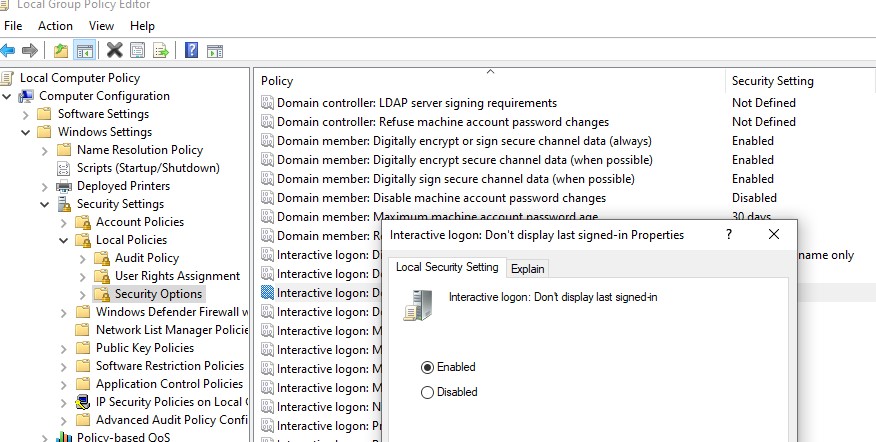
As well, yous can hide the terminal username from the login screen through the registry. To do this go to the registry key HKEY_LOCAL_MACHINE\SOFTWARE\Microsoft\Windows\CurrentVersion\Policies\Organization, create a new DWORD parameter named dontdisplaylastusername with the value one.
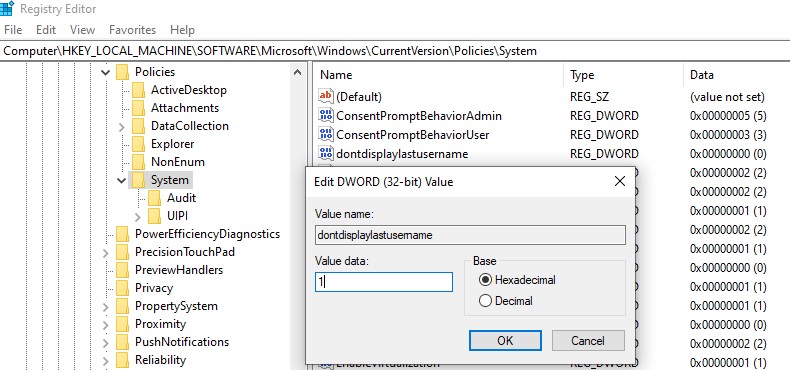
The username is also displayed on the calculator if its screen is locked (by pressing Win+L or via the lock screen GPO). Yous can hide the username on a estimator lock screen. To exercise this, in the same section of the GPO, you must enable the policy "Interactive logon: Display user information when the session is locked" and set the value "Do not display user data .
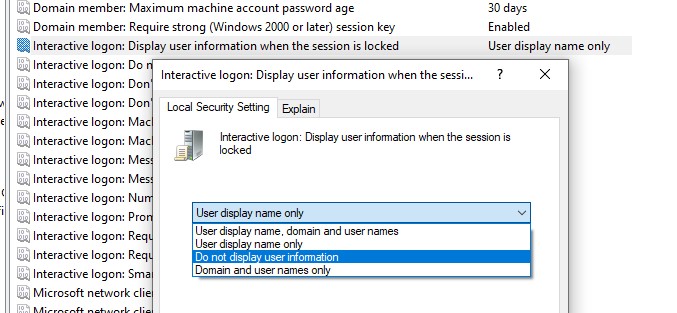
A registry parameter named DontDisplayLockedUserId in the same registry key with a value of 3 matches this policy parameter.
Other possible values for this parameter:
- 1 — testify user brandish proper name, domain, and usernames
- 2 — bear witness only user display names
- 3 — practice not display users.
The computer login screen and Windows lock screen now display the blank username and password fields.
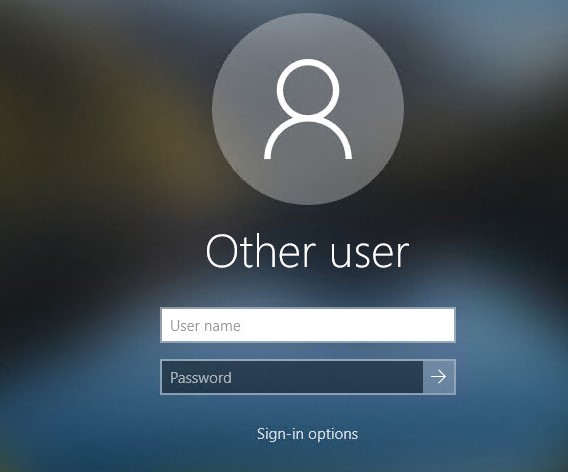
Show All Users on Windows 10/11 Sign-in Screen
By default, modern versions of Windows (tested on Windows 11 21H2 and Windows 10 21H1) always bear witness the list of enabled local users in the bottom left corner of the login screen. Only hidden (see beneath) or disabled users are non displayed.
To log in to the computer, the user just needs to click on the required user business relationship and specify its password. This only works on computers that are non joined to the Agile Directory domain.
If no password is set for the user account, this user volition be automatically logged on, even if autologon is not enabled.
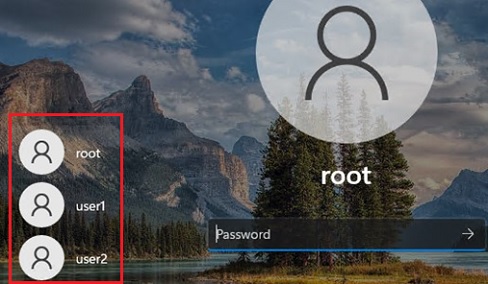
If the listing of local users is not displayed on the computer logon screen, check the settings of the following local Grouping Policy options (use the gpedit.msc):
- Interactive Logon: Do non display last signed-in =
Disabled(Calculator Configuration -> Windows Settings -> Security Settings -> Local Policies -> Security Options); - Enumerate local users on domain-joined computers =
Enabled(Computer Configuration -> Authoritative Templates -> System -> Logon) - Do not enumerate continued users on domain-joined calculator =
Disabled/Non Configured(in the same GPO section)
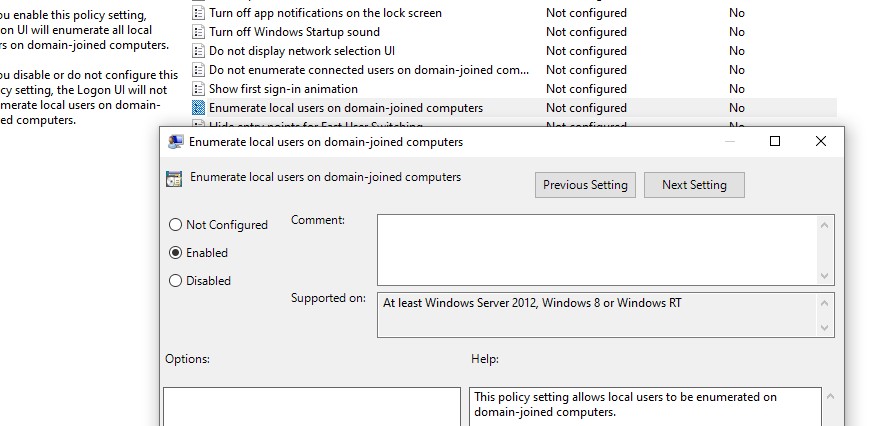
Restart your computer to utilize the new Group Policy settings.
In some old Windows 10 builds (from 1609 upwards to 1903), in that location was some other problem with displaying all local users on the Windows Welcome screen, related to user switching way.
To display all local user accounts on the Windows login screen, you demand to change the value of Enabled parameter to i in the following registry primal: HKEY_LOCAL_MACHINE\SOFTWARE\Microsoft\Windows\CurrentVersion\Hallmark\LogonUI\UserSwitch. This option allows you to switch the electric current user on the Windows sign-in screen. Nevertheless, Windows automatically resets the value of the Enabled parameter to 0 at each user logon.
In order to fix this trouble, you lot demand to create a scheduler job that volition change the parameter value to 0 on each user logon.
You can create a new Scheduler task with PowerShell:
$Trigger= New-ScheduledTaskTrigger -AtLogOn
$User= "NT Say-so\Arrangement"
$Activeness= New-ScheduledTaskAction -Execute "PowerShell.exe" -Argument "Set-ItemProperty -Path HKLM:\SOFTWARE\Microsoft\Windows\CurrentVersion\Hallmark\LogonUI\UserSwitch -Name Enabled -Value 1"
Register-ScheduledTask -TaskName "UserSwitch_Enable" -Trigger $Trigger -User $User -Action $Action -RunLevel Highest –Force

Make sure that the task appeared in Windows Task Scheduler (taskschd.msc).
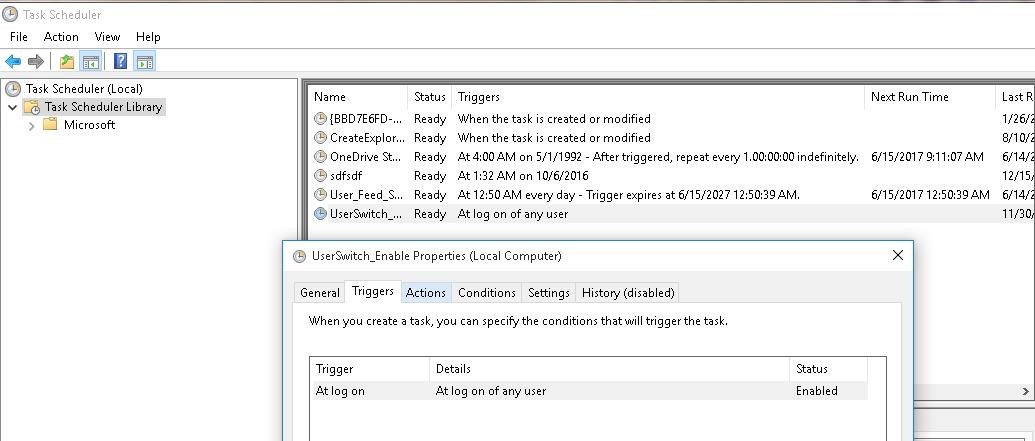
Log off and so log on again. The task must start automatically and change the value of Enabled registry parameter to ane. Check the current value of the parameter using Get-ItemProperty. As you can see, information technology is 1:
get-ItemProperty -Path 'HKLM:\SOFTWARE\Microsoft\Windows\CurrentVersion\Authentication\LogonUI\UserSwitch' -Proper name Enabled

Show Logged In Domain Users on Windows Login Screen
If multiple domain users share the same calculator, you can brandish a listing of users with agile sessions on the welcome screen. An active session means that users are logged into the computer. It can be a shared reckoner (used in user switching mode), kiosks, Windows Server RDS hosts, or Windows xi and 10 devices with multiple RDP connections immune).
To do this, check that in the Computer Configuration -> Windows Settings -> Security Settings -> Local Policies -> Security Options the following policies are disabled:
- Interactive logon: Don't display final signed-in: Disabled
- Interactive logon: Don't brandish username at sign-in: Disabled
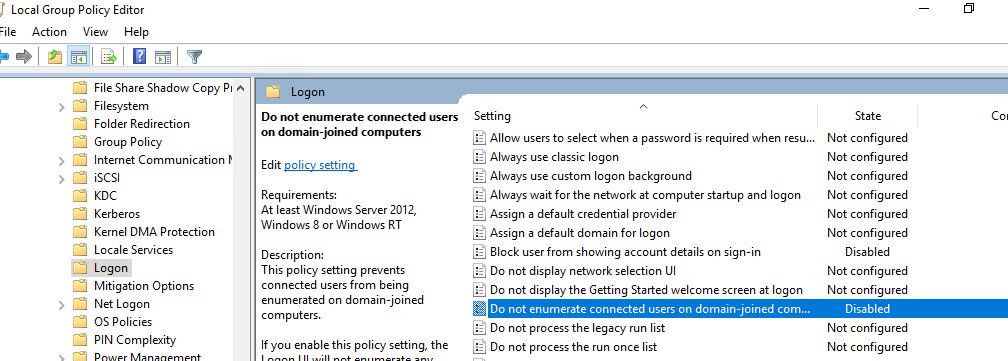
Then disable the policies in the section Calculator Configuration -> Administrative Templates -> System -> Logon:
- Block user from showing account details on sign-in: Disabled
- Do not enumerate connected users on domain-joined reckoner: Disabled
Subsequently that, the welcome screen volition display a listing of logged-on users. Both active sessions and sessions of users with the disconnected status (for example, by RDP timeout) volition exist displayed hither. The user only needs to log in once, and then just select an account from the list and enter a password.
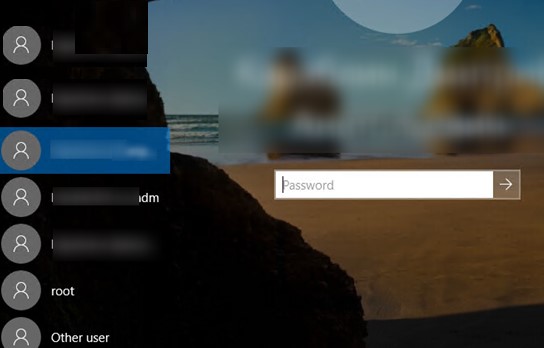
Note that Group Policy settings on domain computers tin can be managed by domain administrators. If one of the local GPO settings doesn't apply to your figurer, check to see if it is overridden by domain GPOs. Use rsop.msc or gpresult to become the resulting Grouping Policy settings on your device.
Hide Specific User Accounts from the Sign-in Screen on Windows 10 and 11
The Windows Welcome screen always displays users who are members of one of the following local groups: Administrators, Users, Power Users, Guests.
Disabled users don't show on the Windows sign-in screen.
You can hide specific users from the listing on the welcome screen through the registry. To do this, you lot need to use the HKLM\SOFTWARE\Microsoft\Windows NT\CurrentVersion\Winlogon\SpecialAccounts\UserList registry fundamental. You demand to create a DWORD parameter with username and value 0 for each user you desire to hide.
Yous can list local user names with PowerShell or cmd:
Net user
Or:
Get-LocalUser | where {$_.enabled –eq $truthful}

To hibernate a specific user business relationship from the Windows xi or 10 welcome screen (for case, user1), run the command:
reg add together "HKLM\SOFTWARE\Microsoft\Windows NT\CurrentVersion\Winlogon\SpecialAccounts\UserList" /t REG_DWORD /f /d 0 /v UserName
If you want to show the hidden user on the login screen again, y'all demand to delete this registry parameter or alter its value to 1.
If the born Windows administrator account is enabled on the estimator, and this is not the only account with local administrator permissions on the computer (!!!), you lot tin hide it as well:
reg add "HKLM\SOFTWARE\Microsoft\Windows NT\CurrentVersion\Winlogon\SpecialAccounts\UserList" /t REG_DWORD /f /d 0 /v administrator
If you desire to hide all users except the last one logged into the figurer, configure the following GPO settings in Computer Configuration -> Administrative Templates -> System -> Logon:
- Enumerate local users on domain—joined computers = Disabled
- Do non enumerate continued users on domain-joined reckoner = Enabled
Windows 10, Remove List of Users on Login Screen
DOWNLOAD HERE
Source: http://woshub.com/how-to-show-all-users-accounts-on-windows-10-login-screen/
Posted by: weibelanwave.blogspot.com